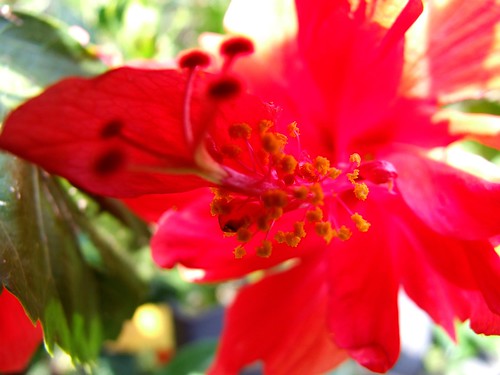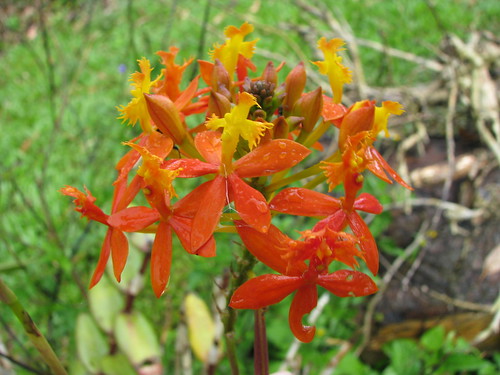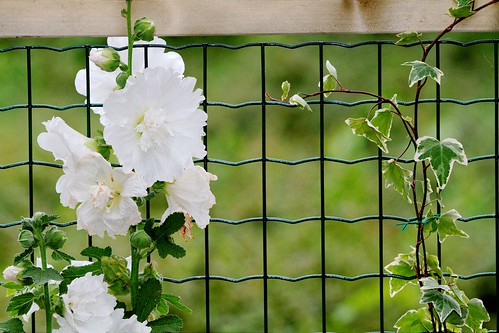Red Hibiscus Flower-Taormina-Sicilia-Italy - Creative Commons by gnuckx
Image by gnuckx
taormina rainbow messina bougainvillea basil basilico hotel san domenico giardini naxos etna volcano vulcano island isola sicilia sicily italia italy sea sun landscape free europe wallpaper michael micky castielli resolution vacation holiday travel flight creativecommons creative commons zero CC0 cc0 CC cc panoramio flickr googleearth maps geotagged gnu gimp wikimedia
Orchid 1608
Image by kahunapulej
Feel free to identify this flower by name in a comment. I just thought
it was pretty and took a picture of it, in spite of my botanical name
knowledge deficiency.
Backyard
Image by F.d.W.
Backyard pictures
Alcea rosea
From Wikipedia, the free encyclopedia
Jump to: navigation, search
Alcea rosea
Scientific classification
Kingdom:
Plantae
(unranked):
Angiosperms
(unranked):
Eudicots
(unranked):
Rosids
Order:
Malvales
Family:
Malvaceae
Genus:
Alcea
Species:
A. rosea
Binomial name
Alcea rosea
L.
Alcea rosea (Common Hollyhock; syn. Althaea chinensis Wall., Althaea ficifolia Cav., Althaea rosea Cav.) is an ornamental plant in the Malvaceae family.
It was imported into Europe from southwestern China during, or possibly before, the 15th century.[1] William Turner, an herbalist of the time, gave it the name "holyoke" from which the English name derives.
Contents
[hide] 1 Cultivation
2 Herbalism
3 Footnotes
4 References
5 External links
[edit] Cultivation
Alcea rosea is variously described as a biennial (having a two-year life cycle), as an annual, or as a short-lived perennial.[2][3][4] It frequently self-sows, which may create a perception that the plants are perennial.[2] The plant may flower during its first year when sown early.[3] It will grow in a wide range of soils, and can easily reach a height of about 8 feet (2.4 m). The flowers are a range of colours from white to dark red, including pink, yellow and orange. Different colours prefer different soils. The darker red variety seems to favour sandy soils, while the lighter colour seems to favour clay soils.[5] The plants are easily grown from seed, and readily self-seed. However, tender plants, whether young from seed or from old stock, may be wiped out by slugs and snails. The foliage is subject to attack from rust (Puccinia malvacearum), which may be treated with fungicides.[6] Commercial growers have reported that some closely related species (Alcea rugosa and Alcea ficifolia) are resistant to this fungus.[7]
[edit] Herbalism
In herbal medicine, Hollyhock is believed to be an emollient and laxative. It is used to control inflammation, to stop bedwetting and as a mouthwash in cases of bleeding gums.[8]
en.wikipedia.org/wiki/Alcea_rosea
Backyard
Image by F.d.W.
Backyard pictures
Alcea rosea
From Wikipedia, the free encyclopedia
Jump to: navigation, search
Alcea rosea
Scientific classification
Kingdom:
Plantae
(unranked):
Angiosperms
(unranked):
Eudicots
(unranked):
Rosids
Order:
Malvales
Family:
Malvaceae
Genus:
Alcea
Species:
A. rosea
Binomial name
Alcea rosea
L.
Alcea rosea (Common Hollyhock; syn. Althaea chinensis Wall., Althaea ficifolia Cav., Althaea rosea Cav.) is an ornamental plant in the Malvaceae family.
It was imported into Europe from southwestern China during, or possibly before, the 15th century.[1] William Turner, an herbalist of the time, gave it the name "holyoke" from which the English name derives.
Contents
[hide] 1 Cultivation
2 Herbalism
3 Footnotes
4 References
5 External links
[edit] Cultivation
Alcea rosea is variously described as a biennial (having a two-year life cycle), as an annual, or as a short-lived perennial.[2][3][4] It frequently self-sows, which may create a perception that the plants are perennial.[2] The plant may flower during its first year when sown early.[3] It will grow in a wide range of soils, and can easily reach a height of about 8 feet (2.4 m). The flowers are a range of colours from white to dark red, including pink, yellow and orange. Different colours prefer different soils. The darker red variety seems to favour sandy soils, while the lighter colour seems to favour clay soils.[5] The plants are easily grown from seed, and readily self-seed. However, tender plants, whether young from seed or from old stock, may be wiped out by slugs and snails. The foliage is subject to attack from rust (Puccinia malvacearum), which may be treated with fungicides.[6] Commercial growers have reported that some closely related species (Alcea rugosa and Alcea ficifolia) are resistant to this fungus.[7]
[edit] Herbalism
In herbal medicine, Hollyhock is believed to be an emollient and laxative. It is used to control inflammation, to stop bedwetting and as a mouthwash in cases of bleeding gums.[8]
en.wikipedia.org/wiki/Alcea_rosea
Tidak ada komentar:
Posting Komentar